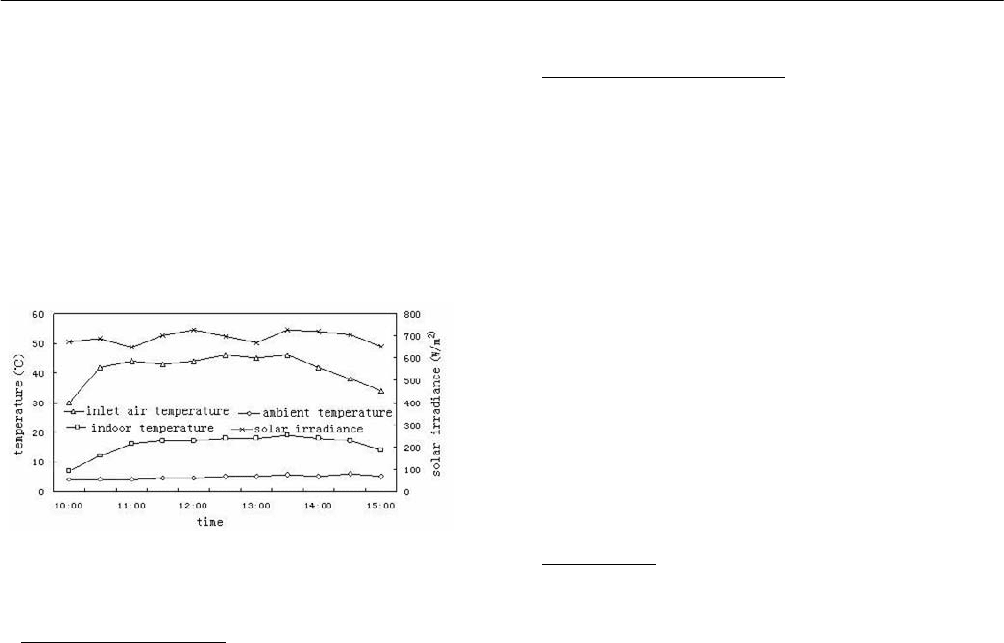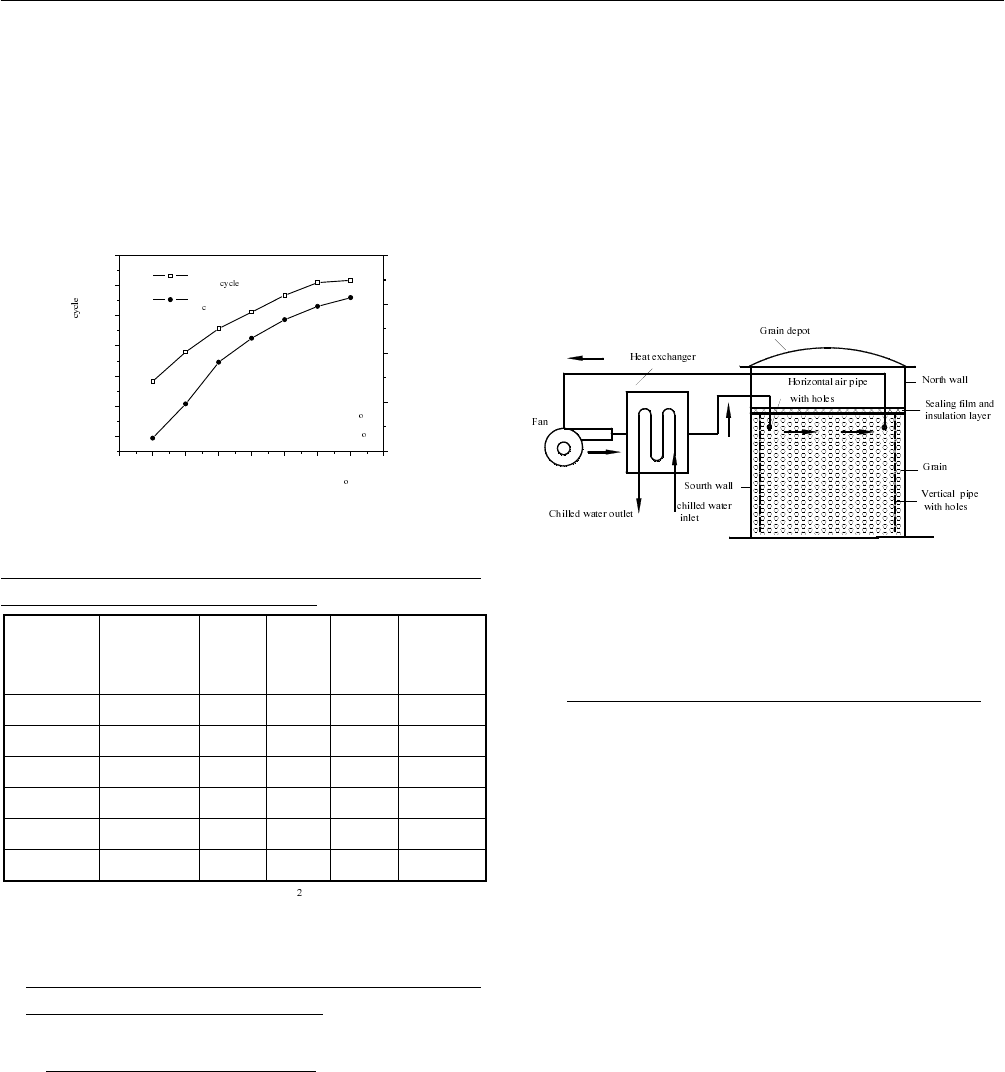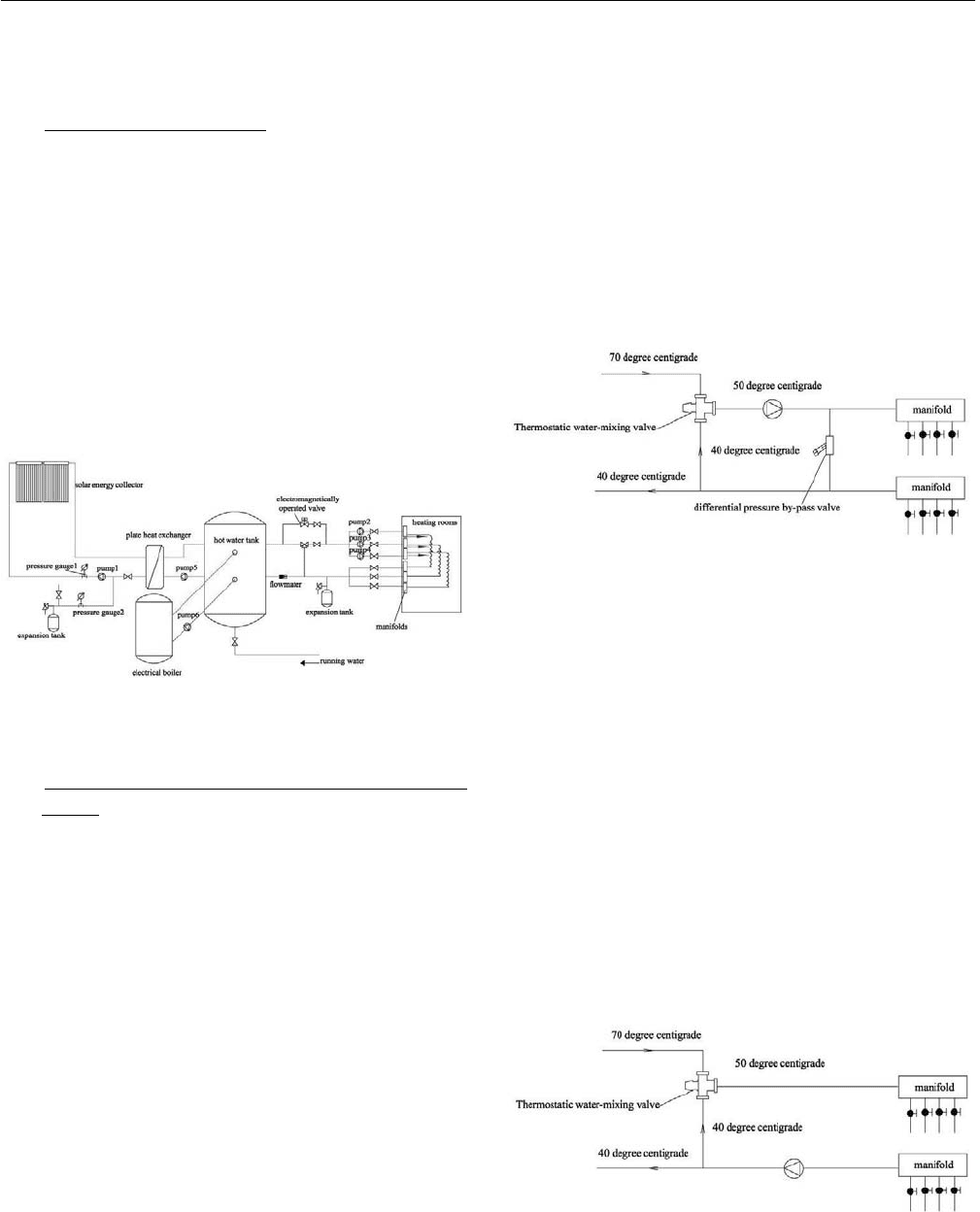Труды Всемирного конгресса Международного общества солнечной энергии - 2007. Том 2
Подождите немного. Документ загружается.


Proceedings of ISES Solar World Congress 2007: Solar Energy and Human Settlement
902
Fig. 5: Variation of efficiency and solar irradiance with
time.
4. HEATING EXPERIMENT WITH SOLAR HOUSE
Based on a single collector tests, two collectors with
ventilating device are applied to the solar house. The wall
of solar house is made of general white ash sand-clay
brick-cement sand material, and every part of building’s
heat transfer coefficient is shown in Table 1, which datum
are shown in Table 1 is that before solar collectors are
connected with the building. The building heat load is: q
H
˙ W/m
2
, building area is 21.9 m
2
.
TABLE 1: HEAT TRANSFER COEFFICIENT OF
BUILDING’S EVERY PART
structure area˄m
2
˅
heat transfer
coefficient
W/( m
2
K)
east wall 13.42 2.03
west wall 11.59 1.85
south wall 7.52 2.03
north wall 7.52 2.03
south window 3.38 2.63
north window 3.38 2.63
ground 17.04 1.5
roof 17.04 1.02
door 1.83 1.96
In order to let enough sunshine into room, we make two
collectors place south widow’s sides vertical, which
connect with the solar house, as shown in Figure 6. In order
to ensure room’s air heated quickly and consider the heated
air’s buoyancy, in the article ducts are made heated air into
room, which connected with a ventilating device near
ground which running can make heated air into room
successfully, as shown in Figure 7. The sketch of heating
system’s structure and air flow are shown in Figure 8.which
working principle is described as follows.
Fig. 6: Sketch of the collectors’ connection.
Fig. 7: Sketch of connection in door.
Fig. 8: Sketch of solar heating framework and air flow.
The heating system’s working principle is: when sunshine
irradiate the air collector, absorber plate absorbs heat
energy which make air temperature arise, ventilation device
start working, fresh air comes from outside into collectors,
then air exchanges caloric with absorber plate to make air
temperature arise, and then into duct, passing ventilating

3 SOLAR COLLECTOR TECHNOLOGIES AND SYSTEMS
903
device into room. Some heated air exchange heat with duct
into room by conduction, some flows into room
directly.The experiment result is shown in Figure 9. And
test time is 2005.12.16, test place is: somewhere in
Zhenjiang, Jiangsu. In the test, ventilating device power is
28 W, aperture area is about 5.7 m
2
. The average irradiance
is 691.6W/ m
2
, average ambient air temperature is 4.ć,
average inlet temperature where ventilating device is 41.3
ć,average room air temperature is 15.7ć.
Fig. 9: Result of heating test with two collectors.
5. EXPERIMENT RESULT
From Figure 3, we can know that the average collector’s
heat efficiency is about 30.4% which under 50% when
solar-wall-air-collector works in natural flow. So under
natural flow, its application has some restraints, but to the
areas where electric power providing is shortage, it still has
great market prospect, and its feasibility and economy need
more analysis. From Figure 5, we can know that the average
efficiency is 60% or so when solar-wall-air-collector works
in force flow, in this way, heat efficiency is improved
obviously, which application is more extensive than natural
flow. From figure 8, we can obtain that the heating system
can ensure building’s indoors average temperature at 15.7ć
when the heat load is 82.6W/m
2
. In this way, we can attain
16ć which indoors require temperature on a whole day.
6. RESULT AND DISCUSSION
The designed solar-wall-air-collector not only structure is
simple also applying is not restrain in space, which heat
efficiency is superior when under force flow condition, and
applied to building can obtain requirement temperature
using less power energy. So this collector can be used in
schools or factories’ heating where has enough sunshine,
also can be used to dry grain, grass and so on. But the
working condition is different, for example, solar irradiance
and collector place way, ambient temperature is all at
unsteady parameter. But in the paper, we only investigate
collector under given place way and nice solar irradiance,
so to the day test is shortage, and to the heat performance
and economy performance of the collector and applying to
building still need more study.
7. REFERNCES
(1) Trombe F, Robert J F. Concretes walls to collect and
hold heat [J]. Solar Age, 1977,2(13)ˈ309-313.
(2) Sebald A V ,Vered G. Design and control tradeoffs for
rockbins in passively solar heated houses with trombe
walls, direct gain and high solar fractions [J]. Solar
Energy, 1987, 39(4):267-289.
(3) Smolec W, Thomas A. Some aspects of trombe wall
heat transfer models [J]. Energy Covers, 1991,
32(3):267-277.
(4) Raman P, Sanjay Mande, Kishore V V N. A passive
solar system for thermal comfort conditioning of
building in composite climates [J]. Solar Energy, 2000,
70(4):319-329.
(5) Zrikem Z,Bilgen E. Theoretical study of a compositive
trombe-michel wall solar collector system [J]. Solar
Energy, 1987, 39(5):409-419.

EXPERIMENTAL INVESTIGATION OF GRAIN LOW-TEMPERATURE STORAGE
WITH A NOVEL SOLAR-POWERED ADSORPTION CHILLER
Huilong Luo
Faculty of Architecture Engineering, Kunming
University of Science and Technology
Kunming 650224, China
huilongluo@tom.com
Ruzhu Wang
Institute of Refrigeration & Cryogenics, Shanghai
Jiao Tong University
Shanghai 200240, China
Yanjun Dai
Institute of Refrigeration & Cryogenics, Shanghai Jiao Tong University
Shanghai 200240, China
ABSTRACT
Low temperature storage of grain can not only inhibit the
respiration of stored grain and extend its storage time, but
also prevent the development of insect and mould. Solar
space cooling appears to be very attractive for low
temperature grain storage because the pattern of availability
of solar energy matches the demand for cooling. In this
study, a novel solar-powered adsorption chiller used for low
temperature grain storage is developed and put into
experimental operation. Test results show that the
solar-powered adsorption chiller can produce a cooling
capacity about 66 to 90W per m
2
collector area, with a
daily solar cooling COP (coefficient of performance) about
0.1 to o.13.
Compared with compression grain chiller, the
solar-powered adsorption chiller shows great energy-saving
potential.
1. INTRODUCTION
At present time, mechanical ventilators and compression
grain chillers are commonly used devices for low
temperature storage of grain [1-2]. For mechanical
ventilators, the initial and operation costs are low.
Nevertheless, sole using mechanical ventilators can not
make the temperature of stored grain drop to a suitable
point in sweltering summer and autumn. The compression
grain chiller, characterized by great cooling power and
large electric power consumption, is essentially an
electrically powered vapor compression refrigeration
system. Although it is an effective device to decrease grain
temperature in depot, the grain chiller is economically
adverse for operation of a grain depot because of its high
operation costs. Hence, it is necessary to develop
alternative refrigeration device for grain cooling storage.
On the other hand, solar adsorption refrigeration
technology has been demonstrated to be feasible during the
past decades [3-5]. Moreover, the cooling load of grain
depot is roughly in phase with solar energy availability.
These indicate that solar adsorption refrigeration system
may be a promising device for grain cooling storage. In this
study, a novel solar-powered adsorption chiller used for low
temperature grain storage is developed and put into
experimental operation successfully.
2. DESCRIPTION OF THE SOLAR-POWERED
ADSORPTION CHILLER
The solar-powered adsorption chiller used for low
temperature grain storage, as shown in Fig. 1, mainly
consists of four subsystems, namely, a solar water heating
unit, a silica gel-water adsorption chiller, a cooling tower

3 SOLAR COLLECTOR TECHNOLOGIES AND SYSTEMS
905
and a fan coil unit. The solar water heating unit is utilized
to produce hot water to drive the adsorption chiller. The
cooling tower offers the cooling water to cool the
condensers and adsorbers. The cooling production is
transferred to grain depot through a fan coil unit. The
adsorption chiller includes two identical adsorption units
and a second stage evaporator with methanol working fluid.
With the help of a vacuum valve (V
11
) and eleven water
valves (V
0
- V
10
), the adsorption chiller can be operated
with a two-adsorber continuous refrigeration cycle with
heat and mass recovery. Two solar-powered adsorption
chillers are constructed and installed in two grain depots in
Jiangsu Province, China. Fig. 2 shows the experimental
setup in the present study.
Legend
Fig. 1: Sketch of the solar-powered adsorption chiller.
Fig. 2: Photograph of the experimental setup.
3. PERFORMANCE OF THE SOLAR-POWERED
ADSORPTION CHILLER
3.1 Adsorption Chiller
The cooling performance of the adsorption chiller under
differential hot water inlet temperature is presented in Fig. 3.
Here Q
c
and COP
cycle
are represented the cooling capacity
and the cooling coefficient of performance during one cycle
respectively. As shown in Fig.3, the suitable hot water
temperature for the adsorption chiller is about 70 to 90 ˚C.
It indicates that the adsorption chiller can be powered by
solar hot water effectively.
3.2 Solar-powered Adsorption Chiller
The solar cooling COP of the system, COP
s
, is defined as
ratio between the useful cooling output of the second stage
evaporator and the total incident solar energy on the surface
of solar collectors:
∫
∫
−
=
IdtA
dtTTCm )(
COP
(1)
Taking no account of the fan coil unit, the total electric
power consumptions of the solar-powered adsorption
chiller include the loads of four water pumps and a cooling
tower fan. Similar to mechanical refrigeration system, the
electrical COP of the solar adsorption chiller, COP
e
, is
defined by
∫
∑
∫
−
=
dtP
dtTTCm
)(
COP
(2)
During the test days, the solar adsorption chiller began to
run when the water temperature in the upper part of the
partitioned hot water tank exceeded about 68 ˚C in the
morning. The outlet temperature of chilled water of the
chiller is controlled to be within 12 to 18˚C. The chiller
stopped running when the water temperature in the upper
part of the partitioned hot water tank was below about
65˚C in the afternoon. Representative measured daily
performance of the solar adsorption chiller is presented in

Proceedings of ISES Solar World Congress 2007: Solar Energy and Human Settlement
906
Table 1. It is seen that the solar-powered adsorption chiller
can produce an average SCP of being about 66 to 90 W/m
2
with a solar cooling COP about 0.096 to 0.13. In addition,
the COP of conventional grain chiller used in China is
about 1.5 to 2.1 [1]. As shown in Table 1, the electrical
COP of the solar adsorption chiller is much higher than that
of conventional grain chiller.
55 60 65 70 75 80 85 90 95
0.12
0.16
0.20
0.24
0.28
0.32
0.36
COP
Q
Hot water inlet temperature ( C)
COP
Chilled water inlet temperature: 18 C
Cooling water inlet temperature: 32
C
2
3
4
5
6
Cooling capacity (kW)
Fig. 3: The cooling performance of the adsorption chiller.
TABLE 1: DAILY PERFORMANCE OF THE SOLAR-
POWERED ADSORPTION CHILLER
Test date
Solar
radiation
(MJ/m
2
)
COP
s
Cop
e
Q
c
(kW)
SCP
*
(W/m
2
)
2004/7/31 19.6 0.123 3.27 4.19 84.8
2004/8/06 20.3 0.125 3.23 4.14 83.8
2004/8/09 17.4 0.096 2.59 3.25 65.7
2004/8/15 19.5 0.131 3.43 4.43 89.7
2004/8/26 18.7 0.124 3.31 4.21 85.2
2004/9/19 16.2 0.109 3.05 3.87 78.3
* SCP represents specific cooling power of per m collector area.
4. EXPERIMENTAL OPERATION ON LOW-TEM-
PERATURE STORAGE OF GRAIN
4.1 Ventilation Model of Grain Depot
In the present study, the solar-powered adsorption chiller is
used to cool the top layer grain in depot. Two ventilation
models are employed in two test grain depots respectively,
namely, depot headspace air layer of circulation ventilation
and internal circulation in the zone of top layer and
edgewise under sealing cover. For air layer of circulation
ventilation, the air layer of grain depot headspace is cooled
by solar-powered adsorption chiller. Hence, the temperature
rise of top layer grain in depot is inhibited effectively
during hot seasons. The Schematic diagram of ventilation
model of internal circulation in the zone of top layer and
edgewise under sealing cover is shown in Fig. 4. This
ventilation model can cool the top layer grain directly
under hot climate conditions. During the period from July
to October, 2004 and May to October, 2005, experimental
operations with two ventilation models were performed.
Fig. 4: Schematic diagram of ventilation model of internal
circulation in the zone of top layer and edgewise
under sealing cover.
4.2 Grain Temperature Variations of Grain Temperature
From July 28 to September 30 of 2004, the solar adsorption
chiller was put into experimental operation to cool the
headspace of a testing grain depot. Fig. 5 shows the
variations of ambient temperature, T
am
, headspace
temperature and top layer grain temperature in the testing
grain depot, T
a-test
and T
tg-test
, and headspace temperature
and top layer grain temperature in a check grain depot
without space cooling, T
a-check
and T
tg-check
, during one test
day. As shown in Fig. 5, although the ambient temperature
is high, the headspace temperature is still below the top
layer grain temperature in the testing grain depot during
most time of a day. Fig. 6 shows the variations of top layer
grain temperature in during the whole experiment period. It
can be seen that, by cooling the grain depot headspace with
the solar adsorption chiller, the increase of top layer grain
temperature can be inhibited effectively during hot seasons.
If the solar adsorption chiller were put into use before the
top layer grain temperature rising to 15 ˚C, the top layer
grain temperature would maintain below 15 to 20 ˚C during
the whole year in most areas in China.

3 SOLAR COLLECTOR TECHNOLOGIES AND SYSTEMS
907
0 2 4 6 8 10 12 14 16 18 20 22 24
24
26
28
30
32
34
36
38
40
42
Temperature ( C)
Time (h)
T T T
T T
Fig. 5. Variations of ambient, headspace and top layer
grain temperature during a test day.
2004-7-21
2004-7-28
2004-8-4
2004-8-11
2004-8-18
2004-8-25
2004-9-1
2004-9-8
2004-9-15
2004-9-22
16
20
24
28
32
Temperature ( C)
Date
T T
Fig. 6: Variations of top layer grain temperature during the
experimental period.
From May 21 to October 7 of 2005, the solar adsorption
chiller was put into experimental operation to internal
circulation ventilation of a testing grain depot.
Fig. 7 shows
the grain temperature variations of top layer under
ventilation model of internal circulation in the zone of top
layer and edgewise under sealing cover during
experimental period. Here,
testtopg
T
−−
and
testtopmidg
T
−−−
are respectively the top and middle-top layer average grain
temperature in test depot,
reftopg
T
−−
and
reftopmidg
T
−−−
are
respectively the top and middle-top layer average grain
temperature in check depot. As shown in Fig.7, the
maximum grain temperature difference of top layer in
experimental and reference depot is about 6.6 °C. For air
layer of circulation ventilation model, the grain temperature
of top layer in experimental depot is about 3.7 °C lower
than that of the check depot. For improving operation
effects of low temperature storage of grain with solar
adsorption chiller, the internal circulation in the zone of top
layer and edgewise under sealing cover model is
recommended. Compared with electrically powered vapor
compression refrigeration grain chiller, the operation costs
of grain low temperature storage under the same climate
conditions are relative low [1, 2].
2005-5-21
2005-6-3
2005-6-17
2005-7-2
2005-7-16
2005-7-31
2005-8-13
2005-8-27
2005-9-11
2005-9-25
2005-10-7
10
12
14
16
18
20
22
24
26
28
30
Temperature / C
Date
T
T
T
T
Fig. 7: Temperature variations of top and middle-top layer
grain.
5. CONCLUSIONS
A kind of solar adsorption chiller was developed for grain
depot cooling. Experimental operations of grain low
temperature with developed solar adsorption chiller were
performed. Based on the test results, the following
conclusions can be drawn.
(1) The developed adsorption chiller can be powered by
evacuated tube solar water heating unit effectively. Its
maximum hourly average special cooling power can reach
about 90 W/m
2
.
(2) The cooling output of this solar adsorption refrigeration
system is roughly in phase with cooling load of grain depot.
In areas with abundant solar resources, such solar
adsorption refrigeration system may provide an alternative
way for grain low temperature storage.

Proceedings of ISES Solar World Congress 2007: Solar Energy and Human Settlement
908
(3) For improving operation effects of low temperature
storage of grain with solar adsorption refrigeration system,
the internal circulation in the zone of top layer and
edgewise under sealing cover model is recommended.
6. NOMENCLATURE
A
c
solar collecting area (m
2
)
C
pw
isobaric specific heat of water (J/kg˚C)
I solar radiation intensity on the top surface
of collector (W/m
2
)
•
m mass flow rate (kg/s)
P pump electric power (W)
T temperature (˚C)
t time (s)
Subscripts
cw chilled water
in inlet
out outlet
7. ACKNOWLEDGMENTS
This work was supported by National Key Technology
R&D program under contract No. 2004BA523B02,
National Key Fundamental Research Program under
contract No. G200026309. The authors thank a lot to Mr.
Z.H. Wang, B.B. Zhang and Y.R. Tong et al. for their
assistance to this work.
8. REFERENCES
(1) W. Hao, Q.X. Zhang, S.P. Yu, et al., The technique and
equipment of cold storage of grain with mechanical
chilling facility. Review of China Agricultural Science
and Technology, 2001, 3(6), 30-35. (In Chinese)
(2) Z. X. Shu, W. Ge. Applications of grain chiller in grain
low-temperature storage. Grain storage, 2001 (2):
35-38.
(3) C. Hildbrand, P. Dind, M. Pons. A new solar powered
adsorption refrigerator with high performance. Solar
Energy 2004; 77(3): 311-18.
(4) R.Z. Wang, R.G. Oliveira. Adsorption refrigeration - An
efficient way to make good use of waste heat and solar
energy. International Sorption Heat Pump Conference,
Denver, CO, USA, 2005, p.1-22.
(5) A. Boubakri., J.J. Guillemiont, F.Meunier. Adsorptive
solar powered ice-maker: experiments and model. Solar
Energy, 2000:69, 249-263.

STUDY OF SOLAR ENERGY FLOOR HEATING SYSTEM
Weng Sijuan, Dou Jianqing, Meng Fanjun
Tsinghua Solar Ltd.
Beijing 102205, China
wengsijuan@thsolar.com
ABSTRACT
A solar energy floor heating system was performed using
all-glass evacuated tube collectors with U-tube and
aluminum fin in YangFan town, Beijing. The total area of
floor heating system is around 640m
2
including exhibited
hall and office area. The contour aperture area of solar
collector system is about 164m
2
and the booster is used by
electrical element of 36kW. The system was co-designed by
Tsinghua Solar Ltd. and KLOBEN, Italy. This paper
introduced the system’s components, operating principle,
thermostatic water supply project and its tracking test. The
temperature of the exhibition hall with floor heating was set
up at 16 . 51.039kWh of the floor heating system was ć
consumed with water cycle operating temperature under
45 during the period of time between Jan. 1, 2004 and ć
Mar. 15, 2004. 30.257kWh was obtained by the solar
collector system. The office room temperature was set up at
16 as well. 39.785kWh of the floor heating system was ć
consumed with water cycle operating temperature under
45 between Nov. 23, 2006 and Feb. 13, 2007. ć
32.836kWh was obtained by the solar collector system. The
experimental results showed that solar fraction of the floor
heating of the exhibition hall and office is 59% and 83%,
respectively.
1. INTRODUCTION
At present, conventional energy is becoming fewer and the
environment is becoming worse. The building energy
consumption continually increases at a high speed. The rate
it taking to total energy consumption grows up from 10% at
the late seventies until now above 30% in domestic.
Building energy-saving becomes an urgent task. Solar
energy is very rich in China. With the solar industry’s
continuous development and the market demand keeping
expand, the field producing low temperature water using
solar energy is being widened. It expands from only
domestic hot water gradually to drying, heating,
air-conditioning etc. Tsinghua Solar Ltd. emonstration
project is the good sample which integrates solar energy
and floor heating together. Make a new-style heating
method with energy saving and environmental protection
become true.
2. SYSTEM COMPONENTS AND OPERATING PRIN-
CIPLE
2.1 Project Overview
The solar floor radiant heating system was co-designed by
Tsinghua Solar Ltd. and KLOBEN, Italy. The total area of
floor heating system is around 640m
2
including exhibited
hall and office area. The contour aperture area of solar
collector system is 164m
2
, which use U-tube collector.
Assist energy supplied by an electric boiler with 36kW
power. The control system uses computer intelligent
monitoring system developed independently by Tsinghua
Solar Ltd. It is able to control equipments real-time, also

Proceedings of ISES Solar World Congress 2007: Solar Energy and Human Settlement
910
record the data of test points and the equipment switch
record.
2.2 System Operating Principles
As shown in figure 1, the solar collector system and floor
heating system are two independent closed systems.
Antifreeze fluid is used as circulation working substance in
collector system. The control system bases on difference in
temperature. The heat gathered from the collector system is
transmitted to thermal storage tank through plate heat
exchanger, which used for floor radiant heating. When the
water temperature is lower than required, the electric boiler
is operated automatically, heat the water in storage tank to
setting temperature.
Fig. 1: Solar energy floor radiant heating system’s
operating schematic diagram.
2.3 Thermostatic Water Supply Project in Floor Heating
System
The temperature of hot water supplied by solar collector
systems ranged between 40 and 99 . The changes scope ćć
is significant. Although general floor heating pipe (such as
PE-Xa, PE-RT etc.) can endure high temperature above
80 , longć -term running will greatly reduce their lifetime.
In condition of significant changing of system temperature,
because of brass joints different from floor heating pipes in
the expansion and contraction coefficient, the long-term
running, the drip problem of the joint is very serious. It
greatly impacts the promotion of solar radiant floor heating.
Therefore floor heating system should control the upper
limit of heat source temperature to not exceed 60 .ć
(required by GB).
To maintain floor heating system operating temperature
around 50 , Floor heating system should use thermostatic ć
water-mixing valve to achieve thermostatic water supply.
Automatic thermostat mixing valve is a special valve,
which has two inlets and one outlet. Temperature sensor
modules are installed in the valve. According to them,
valve set their work.
Figure 2 is one of the schematic diagrams for thermostatic
water-mixing way. In this way, pump is installed before the
outlet of water-mixing valve and after manifolds. When
pressure and flow of water supplied by pipe network
outside
Fig. 2: Thermostatic water-mixing schematic diagram
1.
changed, to maintain water temperature at outlet of
three-way valve at a certain value, Water flow at outlet do
changed inevitably. So the pressure drop of coil for heating
will change accordingly. For the protection of pump, the
installation of differential pressure by-pass valve is
essential.
Through the balance adjust of by-pass valve, the system
circulates at constant pressure, also protects equipment.
Figure 3 is another schematic diagram for thermostatic
water-mixing way. The way pump installed in backwater
pipe, the pump overcomes the resistance by suction.
Although it doesn’t help overcome the coil resistance than
lift, in this way, system does not need the protection of
pressure. So differential pressure by-pass valve can be
omitted, save the cost and simplify the system.
Fig. 3: Thermostatic water-mixing schematic diagram
2.

SOLAR COLLECTOR TECHNOLOGIES AND SYSTEMS
911
Considering the practical features of TH Solar LTD.
demonstration Project in Yang Fan town, we integrated two
projects. The demonstration Project’s building is an
Independent architecture. The water in system stood
constant, and case for heating is single. So accommodating
advantages of both methods, we installed pumps in the
outlet of water-mixing valve, and saved differential
pressure by-pass valve. It not only simplified the system,
also realized the thermostat mixing with water.
3. SYSTEM TESTING
To analysis the energy saving effect of the system, we did
long-term, strict tracking tests. For different purposes, we
recorded the operating results of the system at different
phases and different mode of operation. Test for analysis of
system’s energy saving have
two cases.
Firstly simulating residential building, the indoor
temperature set at 16 all day. During Jan. 1, 2004 to Mar. ć
15, 2004, the quantity of heat the collector system totally
got is 30257KWh, and energy consume for heating is
51039KWh. Solar energy accounts for 59.28ˁ.
Secondly, for the office building, the indoor temperature set
at 16 in the daytime, and set at duty heating temperature ć
5 at night. Nov.23, 2006 to Feb.13, 2007, quantity of heat ć
the collector system totally got is 32836KWh. Electric
boilers took 6949 KWh of electricity. And total energy
consume for heating is 39785 KWh, Solar energy accounts
for 82.53ˁ.
4. CONCLUSIONS
The thermostatic water-mixing is one of the key
technologies of solar radiant floor heating. To ensure the
entire system operate stability, it is very necessary to choice
a reasonable program of the thermostatic water-mixing.
On the condition of the rate that the area of solar energy
collector Vs heating area being 1:3.9, energy supplied by
solar energy collector system takes about 60%,
significantly saving conventional energy.
Compared to keeping room at 16 , we adjust the ć
temperature of room in the night at the on watching
temperature, the rate that solar energy supplied increased
23.94%. At nice weather, energy gained from solar
collector system almost can satisfy the energy needed both
in day time and the first half night. The insufficient part is
supplied by electrical boiler. Solar energy low temperature
hot water floor radiation heating system is more suitable to
office buildings.
5. REFERENCES
(1) Jin Wen, Theodoref Smith. Absorption of Solar Energy
in A Room.Solar Energy Vol. 72, No. 4, 2002: 283-297
(2) http://co.163.com/forum/content/. 2005-11-29
